In pics: old-city buildings along Beijing Central Axis

Tourists visit the Imperial Ancestral Temple in Beijing, capital of China, July 8, 2023.
First created in the Yuan Dynasty (1271-1368), the Beijing Central Axis, or Zhongzhouxian, stretches 7.8 kilometers between the Yongding Gate in the south of the city and the Drum Tower and Bell Tower in the north. Most of the major old-city buildings of Beijing sit along this axis.
Gates, palaces, temples, squares and gardens of the old city are all linked up to the axis. As they witnessed the folk activities along the line from old days to new ones, they themselves are a joy to behold at all times. (Xinhua/Chen Zhonghao)

Tourists visit the Zhongshan Park in Beijing, capital of China, July 15, 2023.
First created in the Yuan Dynasty (1271-1368), the Beijing Central Axis, or Zhongzhouxian, stretches 7.8 kilometers between the Yongding Gate in the south of the city and the Drum Tower and Bell Tower in the north. Most of the major old-city buildings of Beijing sit along this axis.
Gates, palaces, temples, squares and gardens of the old city are all linked up to the axis. As they witnessed the folk activities along the line from old days to new ones, they themselves are a joy to behold at all times. (Xinhua/Li Jing)

People visit the Tian'anmen Square in Beijing, capital of China, July 9, 2023.
First created in the Yuan Dynasty (1271-1368), the Beijing Central Axis, or Zhongzhouxian, stretches 7.8 kilometers between the Yongding Gate in the south of the city and the Drum Tower and Bell Tower in the north. Most of the major old-city buildings of Beijing sit along this axis.
Gates, palaces, temples, squares and gardens of the old city are all linked up to the axis. As they witnessed the folk activities along the line from old days to new ones, they themselves are a joy to behold at all times. (Xinhua/Ren Chao)
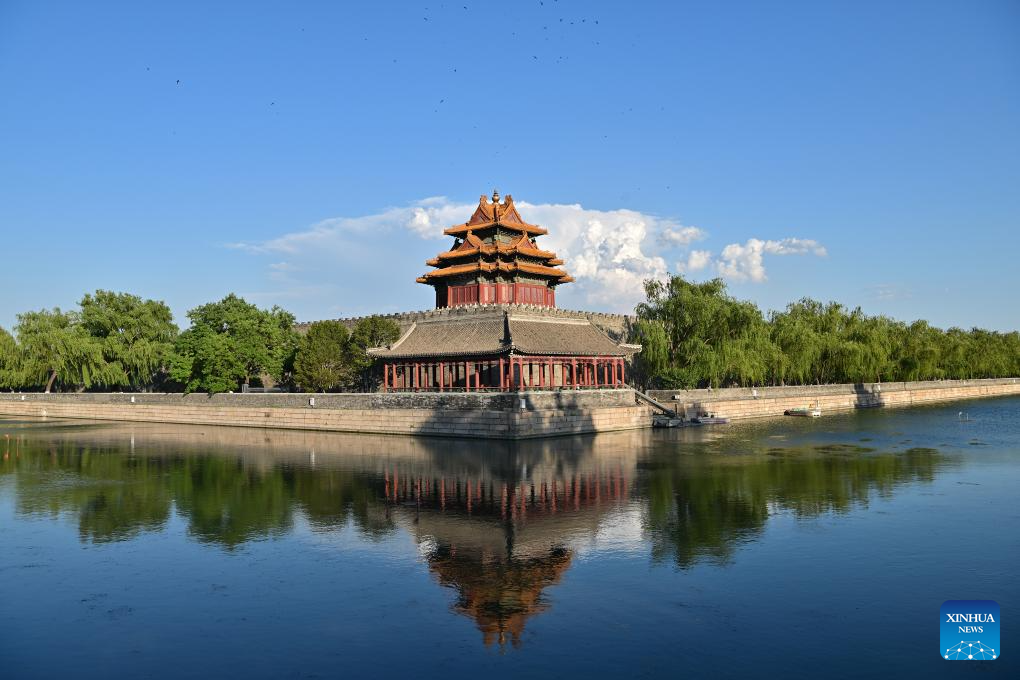
This photo taken on June 20, 2023 shows a turret of the Forbidden City in Beijing, capital of China.
First created in the Yuan Dynasty (1271-1368), the Beijing Central Axis, or Zhongzhouxian, stretches 7.8 kilometers between the Yongding Gate in the south of the city and the Drum Tower and Bell Tower in the north. Most of the major old-city buildings of Beijing sit along this axis.
Gates, palaces, temples, squares and gardens of the old city are all linked up to the axis. As they witnessed the folk activities along the line from old days to new ones, they themselves are a joy to behold at all times. (Xinhua/Li Xin)

People walk on the Wanning Bridge in Beijing, capital of China, July 18, 2023.
First created in the Yuan Dynasty (1271-1368), the Beijing Central Axis, or Zhongzhouxian, stretches 7.8 kilometers between the Yongding Gate in the south of the city and the Drum Tower and Bell Tower in the north. Most of the major old-city buildings of Beijing sit along this axis.
Gates, palaces, temples, squares and gardens of the old city are all linked up to the axis. As they witnessed the folk activities along the line from old days to new ones, they themselves are a joy to behold at all times. (Xinhua/Luo Xiaoguang)

This photo taken on July 18, 2023 shows the Wanning Bridge in Beijing, capital of China.
First created in the Yuan Dynasty (1271-1368), the Beijing Central Axis, or Zhongzhouxian, stretches 7.8 kilometers between the Yongding Gate in the south of the city and the Drum Tower and Bell Tower in the north. Most of the major old-city buildings of Beijing sit along this axis.
Gates, palaces, temples, squares and gardens of the old city are all linked up to the axis. As they witnessed the folk activities along the line from old days to new ones, they themselves are a joy to behold at all times. (Xinhua/Luo Xiaoguang)

This photo taken on July 10, 2023 shows the Yongding Gate in Beijing, capital of China.
First created in the Yuan Dynasty (1271-1368), the Beijing Central Axis, or Zhongzhouxian, stretches 7.8 kilometers between the Yongding Gate in the south of the city and the Drum Tower and Bell Tower in the north. Most of the major old-city buildings of Beijing sit along this axis.
Gates, palaces, temples, squares and gardens of the old city are all linked up to the axis. As they witnessed the folk activities along the line from old days to new ones, they themselves are a joy to behold at all times. (Xinhua/Li He)

This photo taken on July 8, 2023 shows a turret of the Forbidden City in Beijing, capital of China.
First created in the Yuan Dynasty (1271-1368), the Beijing Central Axis, or Zhongzhouxian, stretches 7.8 kilometers between the Yongding Gate in the south of the city and the Drum Tower and Bell Tower in the north. Most of the major old-city buildings of Beijing sit along this axis.
Gates, palaces, temples, squares and gardens of the old city are all linked up to the axis. As they witnessed the folk activities along the line from old days to new ones, they themselves are a joy to behold at all times. (Xinhua/Luo Xiaoguang)

This photo taken on July 10, 2023 shows the Hall of Prayer for Good Harvest of the Temple of Heaven in Beijing, capital of China.
First created in the Yuan Dynasty (1271-1368), the Beijing Central Axis, or Zhongzhouxian, stretches 7.8 kilometers between the Yongding Gate in the south of the city and the Drum Tower and Bell Tower in the north. Most of the major old-city buildings of Beijing sit along this axis.
Gates, palaces, temples, squares and gardens of the old city are all linked up to the axis. As they witnessed the folk activities along the line from old days to new ones, they themselves are a joy to behold at all times. (Xinhua/Mu Wenchun)

This photo taken on July 15, 2023 shows the Altar of Land and Grain in Beijing, capital of China.
First created in the Yuan Dynasty (1271-1368), the Beijing Central Axis, or Zhongzhouxian, stretches 7.8 kilometers between the Yongding Gate in the south of the city and the Drum Tower and Bell Tower in the north. Most of the major old-city buildings of Beijing sit along this axis.
Gates, palaces, temples, squares and gardens of the old city are all linked up to the axis. As they witnessed the folk activities along the line from old days to new ones, they themselves are a joy to behold at all times. (Xinhua/Li Jing)

Tourists visit the Imperial Ancestral Temple in Beijing, capital of China, July 8, 2023.
First created in the Yuan Dynasty (1271-1368), the Beijing Central Axis, or Zhongzhouxian, stretches 7.8 kilometers between the Yongding Gate in the south of the city and the Drum Tower and Bell Tower in the north. Most of the major old-city buildings of Beijing sit along this axis.
Gates, palaces, temples, squares and gardens of the old city are all linked up to the axis. As they witnessed the folk activities along the line from old days to new ones, they themselves are a joy to behold at all times. (Xinhua/Chen Zhonghao)

People visit the Temple of Agriculture in Beijing, capital of China, July 19, 2023.
First created in the Yuan Dynasty (1271-1368), the Beijing Central Axis, or Zhongzhouxian, stretches 7.8 kilometers between the Yongding Gate in the south of the city and the Drum Tower and Bell Tower in the north. Most of the major old-city buildings of Beijing sit along this axis.
Gates, palaces, temples, squares and gardens of the old city are all linked up to the axis. As they witnessed the folk activities along the line from old days to new ones, they themselves are a joy to behold at all times. (Xinhua/Chen Zhonghao)

People visit the Qianmen street in Beijing, capital of China, July 6, 2023.
First created in the Yuan Dynasty (1271-1368), the Beijing Central Axis, or Zhongzhouxian, stretches 7.8 kilometers between the Yongding Gate in the south of the city and the Drum Tower and Bell Tower in the north. Most of the major old-city buildings of Beijing sit along this axis.
Gates, palaces, temples, squares and gardens of the old city are all linked up to the axis. As they witnessed the folk activities along the line from old days to new ones, they themselves are a joy to behold at all times. (Xinhua/Ju Huanzong)

People visit the Qianmen street in Beijing, capital of China, July 8, 2023.
First created in the Yuan Dynasty (1271-1368), the Beijing Central Axis, or Zhongzhouxian, stretches 7.8 kilometers between the Yongding Gate in the south of the city and the Drum Tower and Bell Tower in the north. Most of the major old-city buildings of Beijing sit along this axis.
Gates, palaces, temples, squares and gardens of the old city are all linked up to the axis. As they witnessed the folk activities along the line from old days to new ones, they themselves are a joy to behold at all times. (Xinhua/Ju Huanzong)

People visit the Qianmen street in Beijing, capital of China, July 8, 2023.
First created in the Yuan Dynasty (1271-1368), the Beijing Central Axis, or Zhongzhouxian, stretches 7.8 kilometers between the Yongding Gate in the south of the city and the Drum Tower and Bell Tower in the north. Most of the major old-city buildings of Beijing sit along this axis.
Gates, palaces, temples, squares and gardens of the old city are all linked up to the axis. As they witnessed the folk activities along the line from old days to new ones, they themselves are a joy to behold at all times. (Xinhua/Ju Huanzong)

People take photos of a turret of the Forbidden City in Beijing, capital of China, June 11, 2023.
First created in the Yuan Dynasty (1271-1368), the Beijing Central Axis, or Zhongzhouxian, stretches 7.8 kilometers between the Yongding Gate in the south of the city and the Drum Tower and Bell Tower in the north. Most of the major old-city buildings of Beijing sit along this axis.
Gates, palaces, temples, squares and gardens of the old city are all linked up to the axis. As they witnessed the folk activities along the line from old days to new ones, they themselves are a joy to behold at all times. (Xinhua/Li Xin)

This photo taken on June 21, 2023 shows the Drum Tower as seen from the Jingshan Park in Beijing, capital of China.
First created in the Yuan Dynasty (1271-1368), the Beijing Central Axis, or Zhongzhouxian, stretches 7.8 kilometers between the Yongding Gate in the south of the city and the Drum Tower and Bell Tower in the north. Most of the major old-city buildings of Beijing sit along this axis.
Gates, palaces, temples, squares and gardens of the old city are all linked up to the axis. As they witnessed the folk activities along the line from old days to new ones, they themselves are a joy to behold at all times. (Xinhua/Li Xin)

People visit the Qianmen street in Beijing, capital of China, July 8, 2023.
First created in the Yuan Dynasty (1271-1368), the Beijing Central Axis, or Zhongzhouxian, stretches 7.8 kilometers between the Yongding Gate in the south of the city and the Drum Tower and Bell Tower in the north. Most of the major old-city buildings of Beijing sit along this axis.
Gates, palaces, temples, squares and gardens of the old city are all linked up to the axis. As they witnessed the folk activities along the line from old days to new ones, they themselves are a joy to behold at all times. (Xinhua/Ju Huanzong)

This photo taken on July 10, 2023 shows the Yongding Gate in Beijing, capital of China.
First created in the Yuan Dynasty (1271-1368), the Beijing Central Axis, or Zhongzhouxian, stretches 7.8 kilometers between the Yongding Gate in the south of the city and the Drum Tower and Bell Tower in the north. Most of the major old-city buildings of Beijing sit along this axis.
Gates, palaces, temples, squares and gardens of the old city are all linked up to the axis. As they witnessed the folk activities along the line from old days to new ones, they themselves are a joy to behold at all times. (Xinhua/Li He)

Tourists pose for photos in front of the Hall of Prayer for Good Harvest of the Temple of Heaven in Beijing, capital of China, July 10, 2023.
First created in the Yuan Dynasty (1271-1368), the Beijing Central Axis, or Zhongzhouxian, stretches 7.8 kilometers between the Yongding Gate in the south of the city and the Drum Tower and Bell Tower in the north. Most of the major old-city buildings of Beijing sit along this axis.
Gates, palaces, temples, squares and gardens of the old city are all linked up to the axis. As they witnessed the folk activities along the line from old days to new ones, they themselves are a joy to behold at all times. (Xinhua/Mu Wenchun)

People visit the Temple of Agriculture in Beijing, capital of China, July 19, 2023.
First created in the Yuan Dynasty (1271-1368), the Beijing Central Axis, or Zhongzhouxian, stretches 7.8 kilometers between the Yongding Gate in the south of the city and the Drum Tower and Bell Tower in the north. Most of the major old-city buildings of Beijing sit along this axis.
Gates, palaces, temples, squares and gardens of the old city are all linked up to the axis. As they witnessed the folk activities along the line from old days to new ones, they themselves are a joy to behold at all times. (Xinhua/Chen Zhonghao)

This photo taken on July 15, 2023 shows the Altar of Land and Grain in Beijing, capital of China.
First created in the Yuan Dynasty (1271-1368), the Beijing Central Axis, or Zhongzhouxian, stretches 7.8 kilometers between the Yongding Gate in the south of the city and the Drum Tower and Bell Tower in the north. Most of the major old-city buildings of Beijing sit along this axis.
Gates, palaces, temples, squares and gardens of the old city are all linked up to the axis. As they witnessed the folk activities along the line from old days to new ones, they themselves are a joy to behold at all times. (Xinhua/Li Jing)

This photo taken on July 17, 2023 shows the Drum Tower and Bell Tower in Beijing, capital of China.
First created in the Yuan Dynasty (1271-1368), the Beijing Central Axis, or Zhongzhouxian, stretches 7.8 kilometers between the Yongding Gate in the south of the city and the Drum Tower and Bell Tower in the north. Most of the major old-city buildings of Beijing sit along this axis.
Gates, palaces, temples, squares and gardens of the old city are all linked up to the axis. As they witnessed the folk activities along the line from old days to new ones, they themselves are a joy to behold at all times. (Xinhua/Luo Xiaoguang)

This photo taken on July 8, 2023 shows the Imperial Ancestral Temple in Beijing, capital of China.
First created in the Yuan Dynasty (1271-1368), the Beijing Central Axis, or Zhongzhouxian, stretches 7.8 kilometers between the Yongding Gate in the south of the city and the Drum Tower and Bell Tower in the north. Most of the major old-city buildings of Beijing sit along this axis.
Gates, palaces, temples, squares and gardens of the old city are all linked up to the axis. As they witnessed the folk activities along the line from old days to new ones, they themselves are a joy to behold at all times. (Xinhua/Chen Zhonghao)

This photo taken on July 20, 2023 shows the Zhengyang Gate in Beijing, capital of China.
First created in the Yuan Dynasty (1271-1368), the Beijing Central Axis, or Zhongzhouxian, stretches 7.8 kilometers between the Yongding Gate in the south of the city and the Drum Tower and Bell Tower in the north. Most of the major old-city buildings of Beijing sit along this axis.
Gates, palaces, temples, squares and gardens of the old city are all linked up to the axis. As they witnessed the folk activities along the line from old days to new ones, they themselves are a joy to behold at all times. (Xinhua/Luo Xiaoguang)
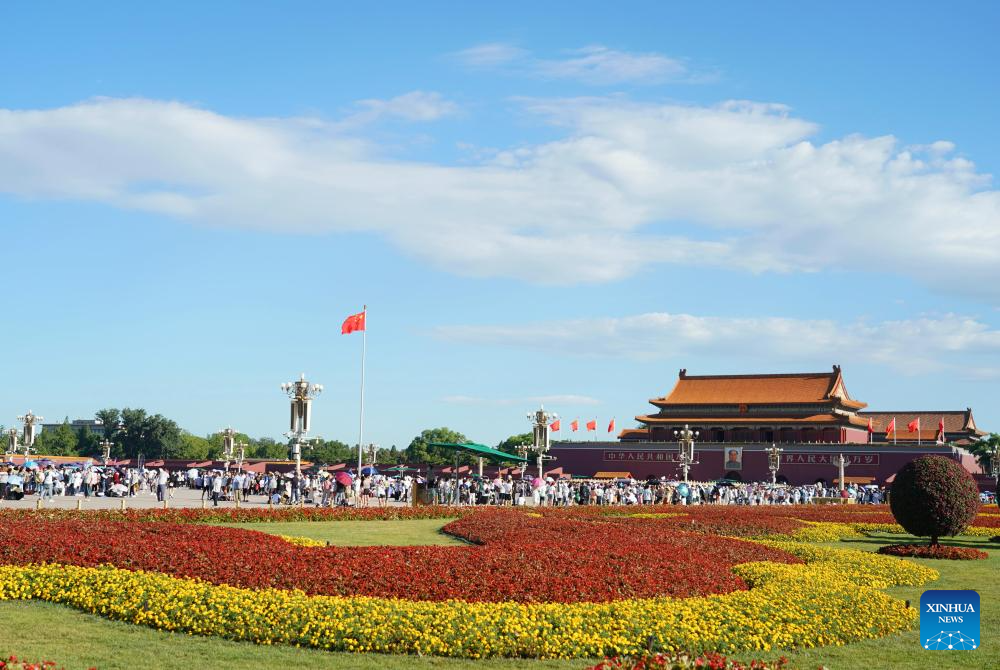
People visit the Tian'anmen Square in Beijing, capital of China, July 9, 2023.
First created in the Yuan Dynasty (1271-1368), the Beijing Central Axis, or Zhongzhouxian, stretches 7.8 kilometers between the Yongding Gate in the south of the city and the Drum Tower and Bell Tower in the north. Most of the major old-city buildings of Beijing sit along this axis.
Gates, palaces, temples, squares and gardens of the old city are all linked up to the axis. As they witnessed the folk activities along the line from old days to new ones, they themselves are a joy to behold at all times. (Xinhua/Ren Chao)

Tourists visit the Jingshan Park in Beijing, capital of China, July 4, 2023.
First created in the Yuan Dynasty (1271-1368), the Beijing Central Axis, or Zhongzhouxian, stretches 7.8 kilometers between the Yongding Gate in the south of the city and the Drum Tower and Bell Tower in the north. Most of the major old-city buildings of Beijing sit along this axis.
Gates, palaces, temples, squares and gardens of the old city are all linked up to the axis. As they witnessed the folk activities along the line from old days to new ones, they themselves are a joy to behold at all times. (Xinhua/Li Xin)

This photo taken on July 10, 2023 shows the Yongding Gate in Beijing, capital of China.
First created in the Yuan Dynasty (1271-1368), the Beijing Central Axis, or Zhongzhouxian, stretches 7.8 kilometers between the Yongding Gate in the south of the city and the Drum Tower and Bell Tower in the north. Most of the major old-city buildings of Beijing sit along this axis.
Gates, palaces, temples, squares and gardens of the old city are all linked up to the axis. As they witnessed the folk activities along the line from old days to new ones, they themselves are a joy to behold at all times. (Xinhua/Li He)
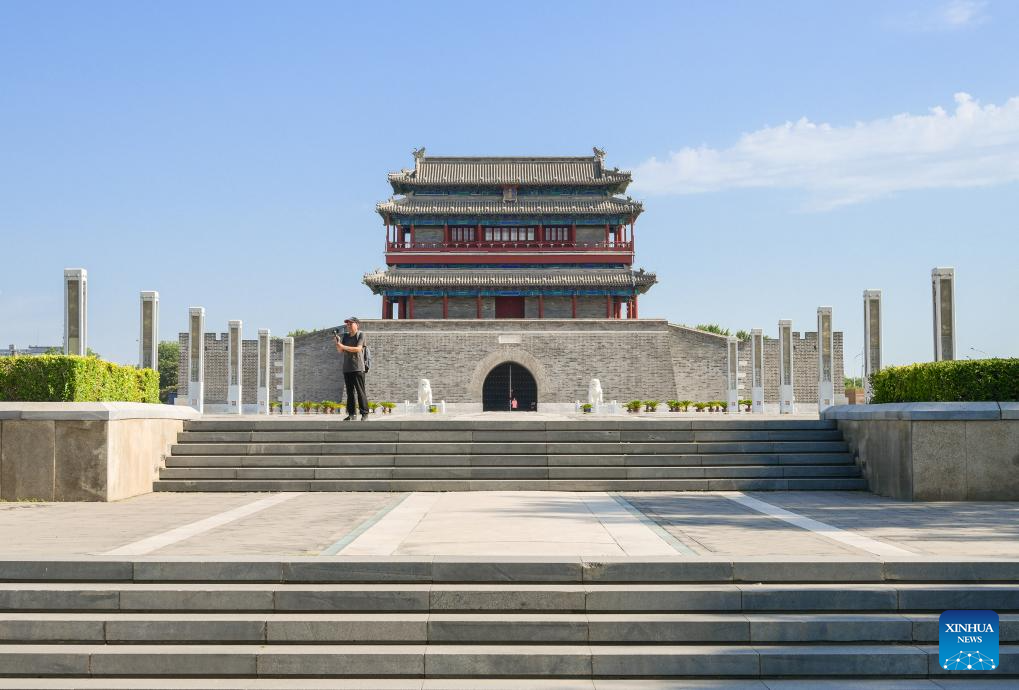
This photo taken on July 10, 2023 shows the Yongding Gate in Beijing, capital of China.
First created in the Yuan Dynasty (1271-1368), the Beijing Central Axis, or Zhongzhouxian, stretches 7.8 kilometers between the Yongding Gate in the south of the city and the Drum Tower and Bell Tower in the north. Most of the major old-city buildings of Beijing sit along this axis.
Gates, palaces, temples, squares and gardens of the old city are all linked up to the axis. As they witnessed the folk activities along the line from old days to new ones, they themselves are a joy to behold at all times. (Xinhua/Li He)
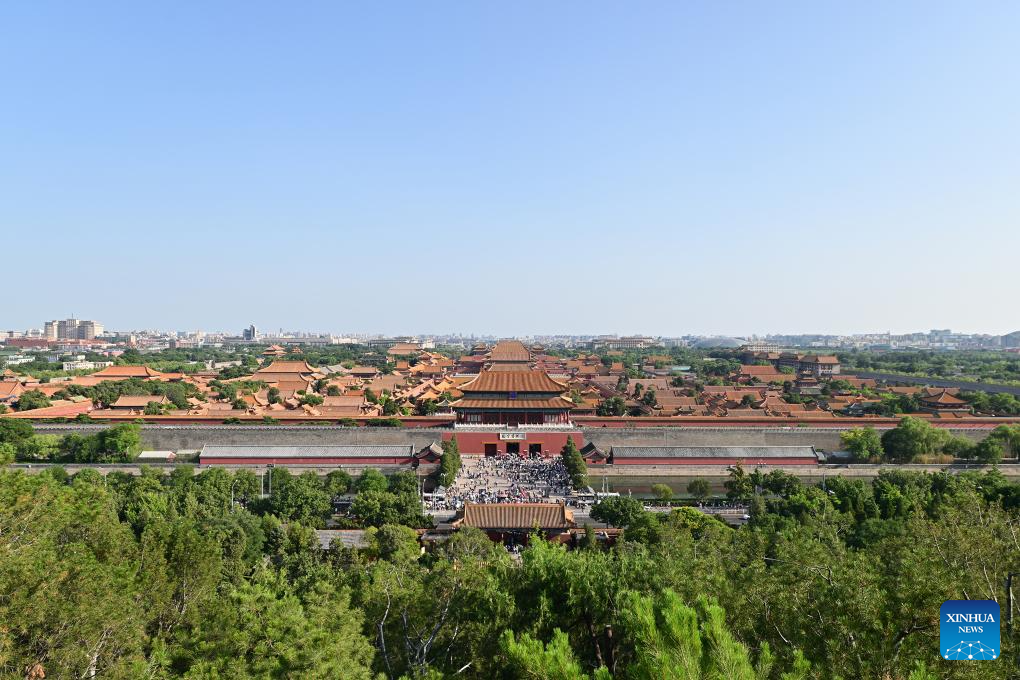
This photo taken on July 4, 2023 shows the Forbidden City in Beijing, capital of China.
First created in the Yuan Dynasty (1271-1368), the Beijing Central Axis, or Zhongzhouxian, stretches 7.8 kilometers between the Yongding Gate in the south of the city and the Drum Tower and Bell Tower in the north. Most of the major old-city buildings of Beijing sit along this axis.
Gates, palaces, temples, squares and gardens of the old city are all linked up to the axis. As they witnessed the folk activities along the line from old days to new ones, they themselves are a joy to behold at all times. (Xinhua/Li Xin)

This photo taken on July 17, 2023 shows the Drum Tower and Bell Tower in Beijing, capital of China.
First created in the Yuan Dynasty (1271-1368), the Beijing Central Axis, or Zhongzhouxian, stretches 7.8 kilometers between the Yongding Gate in the south of the city and the Drum Tower and Bell Tower in the north. Most of the major old-city buildings of Beijing sit along this axis.
Gates, palaces, temples, squares and gardens of the old city are all linked up to the axis. As they witnessed the folk activities along the line from old days to new ones, they themselves are a joy to behold at all times. (Xinhua/Luo Xiaoguang)

People exercise in front of the Bell Tower in Beijing, capital of China, July 18, 2023.
First created in the Yuan Dynasty (1271-1368), the Beijing Central Axis, or Zhongzhouxian, stretches 7.8 kilometers between the Yongding Gate in the south of the city and the Drum Tower and Bell Tower in the north. Most of the major old-city buildings of Beijing sit along this axis.
Gates, palaces, temples, squares and gardens of the old city are all linked up to the axis. As they witnessed the folk activities along the line from old days to new ones, they themselves are a joy to behold at all times. (Xinhua/Luo Xiaoguang)

Lotus flowers are pictured beside the Wanning Bridge in Beijing, capital of China, July 18, 2023.
First created in the Yuan Dynasty (1271-1368), the Beijing Central Axis, or Zhongzhouxian, stretches 7.8 kilometers between the Yongding Gate in the south of the city and the Drum Tower and Bell Tower in the north. Most of the major old-city buildings of Beijing sit along this axis.
Gates, palaces, temples, squares and gardens of the old city are all linked up to the axis. As they witnessed the folk activities along the line from old days to new ones, they themselves are a joy to behold at all times. (Xinhua/Luo Xiaoguang)

This photo taken on June 20, 2023 shows a turret of the Forbidden City in Beijing, capital of China.
First created in the Yuan Dynasty (1271-1368), the Beijing Central Axis, or Zhongzhouxian, stretches 7.8 kilometers between the Yongding Gate in the south of the city and the Drum Tower and Bell Tower in the north. Most of the major old-city buildings of Beijing sit along this axis.
Gates, palaces, temples, squares and gardens of the old city are all linked up to the axis. As they witnessed the folk activities along the line from old days to new ones, they themselves are a joy to behold at all times. (Xinhua/Li Xin)

This photo taken on July 9, 2023 shows the Tian'anmen Rostrum in Beijing, capital of China.
First created in the Yuan Dynasty (1271-1368), the Beijing Central Axis, or Zhongzhouxian, stretches 7.8 kilometers between the Yongding Gate in the south of the city and the Drum Tower and Bell Tower in the north. Most of the major old-city buildings of Beijing sit along this axis.
Gates, palaces, temples, squares and gardens of the old city are all linked up to the axis. As they witnessed the folk activities along the line from old days to new ones, they themselves are a joy to behold at all times. (Xinhua/Ren Chao)

People walk past the Tian'anmen Rostrum in Beijing, capital of China, July 9, 2023.
First created in the Yuan Dynasty (1271-1368), the Beijing Central Axis, or Zhongzhouxian, stretches 7.8 kilometers between the Yongding Gate in the south of the city and the Drum Tower and Bell Tower in the north. Most of the major old-city buildings of Beijing sit along this axis.
Gates, palaces, temples, squares and gardens of the old city are all linked up to the axis. As they witnessed the folk activities along the line from old days to new ones, they themselves are a joy to behold at all times. (Xinhua/Ren Chao)
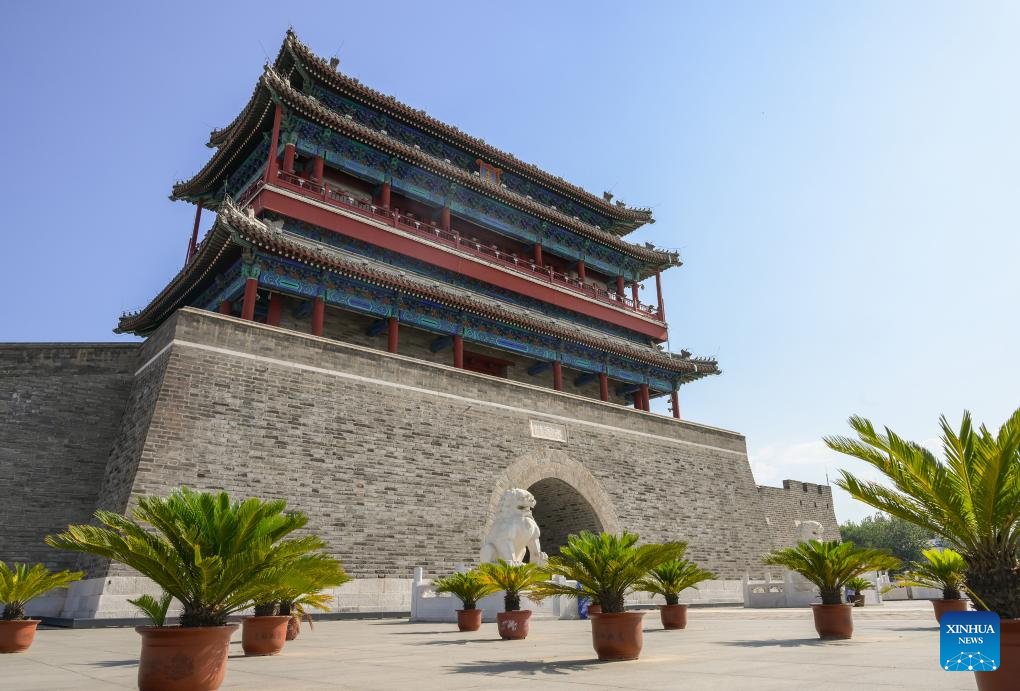
This photo taken on July 10, 2023 shows the Yongding Gate in Beijing, capital of China.
First created in the Yuan Dynasty (1271-1368), the Beijing Central Axis, or Zhongzhouxian, stretches 7.8 kilometers between the Yongding Gate in the south of the city and the Drum Tower and Bell Tower in the north. Most of the major old-city buildings of Beijing sit along this axis.
Gates, palaces, temples, squares and gardens of the old city are all linked up to the axis. As they witnessed the folk activities along the line from old days to new ones, they themselves are a joy to behold at all times. (Xinhua/Li He)
Source:Xinhua Editor:zouyukun
(Source_title:In pics: old-city buildings along Beijing Central Axis)